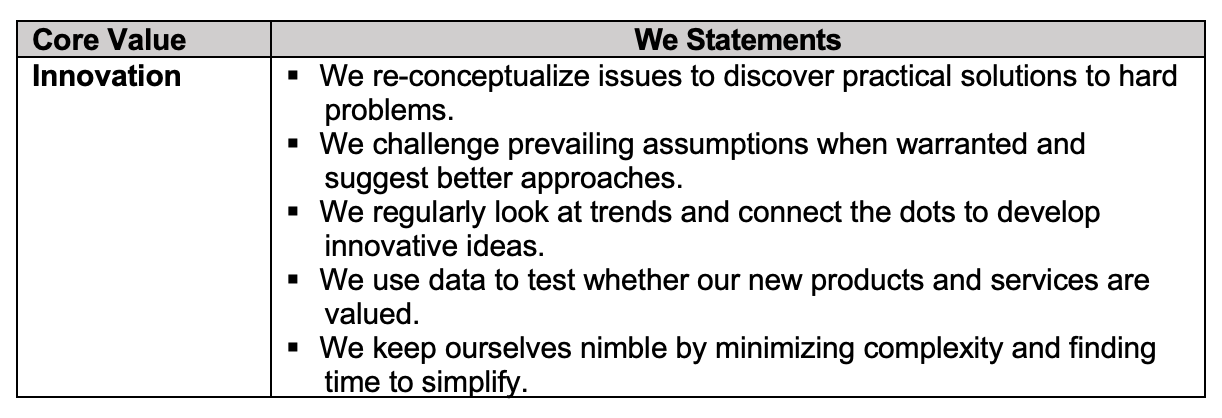
I imagine my son, even today, still wondering what his dad does.
In this blog, I want to share examples of important conversations we’ve facilitated with groups – specifically, leadership teams. And how those conversations can be a powerful tool in the organization’s core values, impact, and success.
First, let me explain that it is typically the CEO or executive director who invites us in. They want a professional facilitator to guide the discussion. Second, the purpose of these meetings is not to deal with day-to-day operational issues but to focus on bigger questions with long-term consequences for the organization.
Some of our more recent discussions have been focusing on customer and employee perceptions. For example:
Related questions would be:
These conversations aim to create a shared understanding of the bigger picture and value of the organization. And this leads us to a key concept: the values-driven organization.
We’ve all heard of values-driven organizations. Many of us work for organizations that claim to be – or aspire to be – truly values driven.
So, how do you know if and when your organization is truly values driven? What do they do differently?
Without hesitation, I can tell you that when they have to make a decision that requires a tradeoff between profits or money versus benefits to society and their customers, they always choose the latter.
I was listening to the CEO of a large non-profit speak about his vision. He said: “In order for us to survive, we have to appeal to people’s higher sense of values and purpose. That is the only thing that will enable us to attract the talented people we need, it’s the only thing that will make us attractive over the long-term to our customers, and it’s what will make us sustainable as a company.”
He said a key step in ensuring his organization would have a crystalized understanding of its long-term value is to determine, communicate, and operate through a clear set of core values. The next section of this blog shares some insight into how that can be accomplished.
 Core values are the enduring things that an organization says are essential to its success. It has been shown that organizations with well-understood core values out-perform those that don’t. Particularly in large organizations, the application of a consistent set of core values distinguishes highly effective organizations from mediocre ones.
Core values are the enduring things that an organization says are essential to its success. It has been shown that organizations with well-understood core values out-perform those that don’t. Particularly in large organizations, the application of a consistent set of core values distinguishes highly effective organizations from mediocre ones.
The reason? Without clear core values, organizations lack a litmus test for making decisions about strategic priorities.
An organization’s values can be difficult to define precisely. We are surrounded by different value systems – including our personal values, our community’s values, and the values of the larger society to which we belong. It can be difficult to sort through them all and be clear about the organization’s values. The question we ask is: What is most important to the organization? What would it say if it could speak for itself? What does it value most? Is it customer service? Or reliability? Is it financial sustainability? And what do we mean by these terms? In order for the values to be useful, the meanings must be clear.
We’ve found that it helps to link core values to more specific and tangible behaviors, often using what we call “we statements.” Here is an excerpt from one organization’s core values: Here is another example:
Here is another example:
The process of developing core values should ideally engage a broad array of people across the organization. A planning team representing leaders of the company should take responsibility for figuring out the process, making sure that managers and employees are engaged, and drafting various iterations of the core values and “we statements.” Once the team has gathered sufficient feedback, the core values should be finalized and then broadly communicated by the company’s leadership.
Here are three prompt questions that can be used to facilitate feedback and solicit input into the core values and “we statements.”
Implementing the core values
Once defined and communicated across the organization, the core values should help inform how people make decisions. Leaders should model the way by asking: “How can our core values guide us in making this decision?” For example, if the company is considering alternative investments in new information technology or new safety equipment, its leader might ask: “Which investment is most in alignment with our core values?”
If your company is serious about its core values, then it should be serious about hiring and promoting people who exemplify them. The core values and “we statements” should inform the recruitment and hiring process, evaluations of employees (including senior managers), and promotions.
Core values should also be communicated to your customers, so that they know what your company stands for and what it considers essential to its success. These should not be mere window dressing. If exceeding customer expectations is a core value, then say so, but also show exactly how that’s being realized throughout the company. If being financially sustainable is a core value, then say so, but also define what that means in terms of investments and policies.
Measuring the core values
Since core values define what is essential to the organization’s success, it makes sense to invest in measuring whether the core values and “we statements” are being observed in practice. Measuring the trend over time can reveal valuable information about whether the organization is aligned around its values.
Some core values, like customer service, are relatively easy to measure. Others, such as ethical behavior and teamwork, are a bit trickier. But all of them can be measured, typically via surveys of customers, employees, and other stakeholders.
Below are examples of two core values and related performance measures:
 Ultimately, a well-structured set of core values forms the DNA of a high-performing organization, where people view themselves as stewards of something more important than themselves and make investments in sustaining the success of the values-driven organization.
Ultimately, a well-structured set of core values forms the DNA of a high-performing organization, where people view themselves as stewards of something more important than themselves and make investments in sustaining the success of the values-driven organization.
In conclusion, discussing the bigger picture requires commitment and a dedication to operating through core values. And developing an organization’s core values is not easy. But the payoff is big: Having a clear understanding of the bigger picture and a set of core values is vital to the organization’s continued impact and long-term success.
If you’re looking to learn more about developing core values or if you’re ready to take your organization to the next level, contact us to speak with a consultant.
Leading Resources, Inc. is a Sacramento Leadership Coaching firm that develops leaders and leading organizations. Subscribe to our leadership development newsletter to download the PDF – “The 6 Trust-Building Habits of Leaders” to learn more about how to build trust with your team.